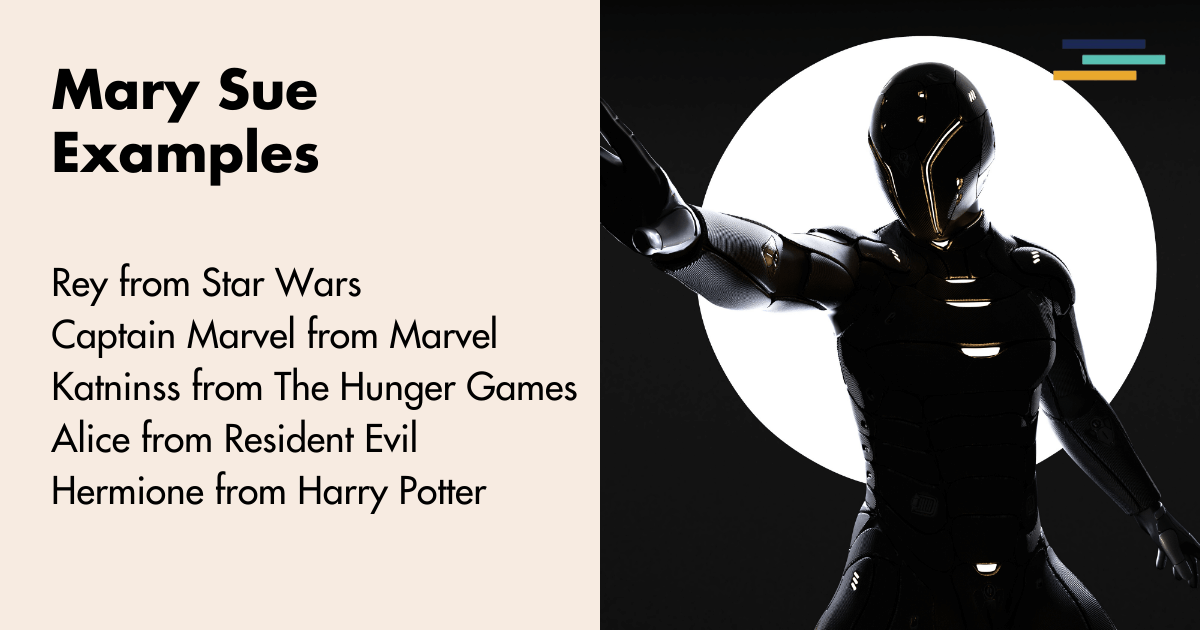
In the world of storytelling, the term “Mary Sue” often sparks heated debates and strong opinions.
And who doesn’t love a strong literary opinion?
Originally coined in the realm of fan fiction, the concept has since permeated mainstream literature and media.
At its core, a Mary Sue is a character who seems to lack flaws and struggles, appearing almost too perfect and capable. These characters can overshadow more complex and relatable figures, leading to imbalances in a story.
While some see the Mary Sue trope as a way to fulfill fantasies and explore idealized versions of oneself, others criticize it for undermining realistic character development and tension. Understanding the nuances of this trope can help you create more balanced and engaging characters, regardless of the genre you’re working in.
How cool is that?
In this article, we’ll delve into the meaning and origin of the Mary Sue, explore examples from film and literature, discuss the potential benefits of this trope, and provide practical tips for writing characters who avoid falling into the Mary Sue trap.
By the time we’re done, you’ll be a Mary Sue on the topic of the Mary Sue trope.
Meta, or what?
What Is a Mary Sue?
Mary Sue Definition
A Mary Sue is a fictional character who is unrealistically perfect, often possessing exceptional abilities and lacking significant flaws. These characters can overcome any obstacle with ease, making them seem implausible and unrelatable.
Typically, Mary Sues are central to their stories, with plots often bending around their needs and desires. The term is used to critique characters who disrupt the balance of a narrative by being overly idealized and not facing meaningful challenges.

Mary Sue Origin
The term “Mary Sue” originated in 1973 with Paula Smith’s satirical Star Trek fan fiction, “A Trekkie’s Tale.”
In this story, Lieutenant Mary Sue, a fifteen-year-old prodigy, outshines the established characters in every way. Smith’s parody highlighted the tendency in fan fiction to create overly perfect self-insert characters.
Over time, the term has expanded beyond fan fiction to describe any character in literature, film, or television who is improbably perfect and lacks depth.
Mary Sue Examples in Film
Rey from Star Wars
Rey, the protagonist of the Star Wars sequel trilogy, often gets labeled a Mary Sue.
Critics argue she masters the Force and combat skills too quickly, surpassing characters like Luke Skywalker who underwent extensive training. Her innate abilities and rapid progression can feel unearned, making her less relatable.
Supporters argue Rey’s character arc is consistent with the mythic structure of Star Wars, where characters often exhibit extraordinary capabilities.
Captain Marvel from the Marvel Cinematic Universe
Captain Marvel, portrayed by Brie Larson, gets criticized as a Mary Sue because of her immense power and the minimal challenges she faces.
Her abilities appear virtually limitless, and she quickly overcomes obstacles that typically require significant effort. This has led to debates about whether her characterization diminishes the tension and relatability that come from characters facing genuine struggles and growth.
Katniss Everdeen from The Hunger Games
Katniss Everdeen, played by Jennifer Lawrence in The Hunger Games series, gets called a Mary Sue.
Despite her interesting backstory and struggles, some argue that her proficiency in survival skills, archery, and leadership come too easily. Katniss also has significant emotional depth and flaws, balancing her strengths with vulnerabilities, which adds complexity to her character, which might just save her from falling prey to the Mary Sue trap.
Alice from Resident Evil
Alice, portrayed by Milla Jovovich in the Resident Evil film series, gets branded a Mary Sue.
Her character has exceptional combat skills, intelligence, and resilience. She often single-handedly takes down hordes of zombies and powerful enemies. Her almost superhuman abilities and lack of significant weaknesses make her less relatable to the audience, fitting the Mary Sue trope.
Hermione Granger from Harry Potter
While Hermione Granger, played by Emma Watson in the Harry Potter series, is a beloved character, some critics argue she exhibits Mary Sue traits.
Hermione is highly intelligent, excels academically, and often has the answers to complex problems. Despite facing challenges, her near-perfection and the admiration she receives from others can sometimes overshadow the struggles that make characters more relatable.

Mary Sue Character Examples in Literature
Anastasia Steele from Fifty Shades of Grey
Anastasia Steele, the protagonist of E. L. James’s Fifty Shades of Grey, gets labelled a Mary Sue.
Her character is exceptionally beautiful and desired by many, including the wealthy and enigmatic Christian Grey. Despite her initial inexperience, she adapts quickly to complex situations, which some critics argue feels unrealistic.
Anastasia’s journey, filled with dramatic twists and turns, often lacks the gradual character development found in more nuanced stories.
Eragon from The Inheritance Cycle
In Christopher Paolini’s The Inheritance Cycle, Eragon, a young farm boy, discovers he is a dragon rider.
Despite his humble beginnings, Eragon quickly masters sword fighting, magic, and dragon riding. His rapid advancement and the adoration he receives can make him seem like a Mary Sue.
However, Paolini’s extensive world-building and Eragon’s internal struggles provide depth that somewhat mitigates this perception.
Bella Swan from Twilight
Bella Swan of Stephenie Meyer’s Twilight series gets described as a Mary Sue because of her significant appeal to nearly all the other characters and her lack of substantial flaws.
Her relationship with Edward Cullen and the ease with which she integrates into the vampire world contribute to this perception. Bella’s character often seems more reactive than proactive, with the plot driving her development rather than her actions influencing the plot.
Richard Cypher from The Sword of Truth
Richard Cypher, the protagonist of Terry Goodkind’s The Sword of Truth series, exhibits Mary Sue traits.
The author portrays him as morally righteous, physically strong, and exceptionally skilled. His quick mastery of complex skills and the adoration he garners from other characters can make him seem overly perfect.
However, Richard’s internal conflicts and the philosophical themes explored in the series add layers to his character.
Aelin Galathynius from Throne of Glass
Aelin Galathynius, the heroine of Sarah J. Maas’s Throne of Glass series, often gets the Mary Sue label.
She’s beautiful, powerful, and adept at various skills, from combat to magic. Aelin’s near-perfect attributes and the admiration she receives from others can overshadow her struggles.
However, Maas also delves into Aelin’s emotional and psychological battles, providing a more nuanced portrayal.
The Benefit of the Mary Sue Trope
While often criticized, the Mary Sue trope can serve several purposes:
- Escapism: Mary Sue characters offer readers escapism, allowing them to envision themselves as highly capable and beloved figures. This is appealing in fantasy and science fiction genres where readers seek to immerse themselves in idealized worlds.
- Wish-Fulfillment: These characters often represent an author’s or reader’s aspirations, providing a platform for exploring idealized versions of oneself. This can be a powerful tool for exploring themes of empowerment and self-discovery.
- Plot Advancement: Mary Sues can drive the plot forward by bypassing lengthy training or development arcs. This can keep the narrative focused on action and adventure, maintaining a fast pace that keeps readers engaged.
- Inspiration: Despite their flaws, Mary Sues can inspire readers to pursue their own goals and believe in their potential. Their unwavering confidence and success can serve as motivational examples.
- Highlighting Themes: Mary Sue characters can highlight certain themes or messages within a story. For example, their perfection can be a critique of unrealistic societal standards or a reflection of an ideal that characters strive towards.

Tips for Writing a Mary Sue Character
- Balance Perfection with Flaws: Ensure your character has relatable flaws and weaknesses. Perfect characters can seem unrealistic and unengaging. For instance, while your character might excel in combat, they could struggle with interpersonal relationships or self-doubt.
- Develop Their Backstory: Give your character a rich backstory that explains their abilities and traits. Avoid giving them skills without proper context or training. For example, a character who is an expert swordsman should have a detailed history of training and mentorship.
- Create Meaningful Challenges: Put your character through significant struggles and obstacles. Their growth should come from overcoming these challenges, not from innate perfection. Consider how these challenges affect their development and shape their personality.
- Foster Realistic Relationships: Ensure that relationships and interactions with other characters are nuanced and believable. Avoid having everyone love or hate your character without a good reason. Relationships should develop naturally, reflecting the character’s actions and decisions.
- Show Vulnerability: Allow your character to show vulnerability and doubt. This makes them more human and relatable. A powerful mage might hesitate in a critical moment, revealing their fear of failure or responsibility.
- Avoid Overpowered Traits: Be cautious about giving your character too many exceptional abilities or traits. Balance their skills with believable limitations. An archer with perfect aim might struggle with close combat or suffer from a physical ailment that affects their performance.
- Reflect on Realism: Even in fantasy, a sense of realism can ground your character. Consider how they fit into their world and how their actions affect those around them. A character’s decisions should have realistic consequences, adding depth to the narrative.
- Internal Conflicts: Incorporate internal conflicts and emotional struggles. A Mary Sue character can become more relatable if they face inner demons or moral dilemmas that challenge their perfect exterior.
- Consistent Growth: Show consistent growth and learning. Even a character who starts out as highly capable should have room to grow and strengthen throughout the story. Significant milestones and development should mark their journey.
- Feedback from Others: Include feedback and critique from other characters within the story. This can provide a balanced perspective and highlight areas where the Mary Sue might need to improve or change.
- Limit Special Treatment: Avoid giving your character special treatment by other characters or the plot without justification. Their achievements and status should feel earned and realistic within the context of the story.
- Balance Screen Time: Ensure that other characters have opportunities to shine and contribute to the story. This prevents the narrative from feeling dominated by the Mary Sue and allows for a more balanced and diverse cast.
- Incorporate Failures: Show your character experiencing failure and learning from it. This adds depth and realism to their journey, demonstrating that even the most capable characters face setbacks and grow from them.
- Use Beta Readers: Get feedback from beta readers or critique partners who can provide an outside perspective. They can help identify areas where your character may come across as too perfect or unrealistic.
- Emphasize Team Effort: Highlight the importance of teamwork and collaboration. Even if your character is highly skilled, show that they rely on others and that their success is a collective effort. This fosters a more dynamic and engaging narrative.
By thoughtfully incorporating these elements, you can create a well-rounded and engaging character who avoids the pitfalls of the Mary Sue trope. Strive for a balance between idealization and relatability, ensuring your characters resonate with readers on a deeper level.
And finally, always remember that story comes first. Focus on:
- Creating engaging characters
- Penning interesting plots
- Structuring solid settings
A tool like Fictionary helps you turn your draft into an interesting story readers love. So, with a strong narrative foundation, your writing can truly shine.


